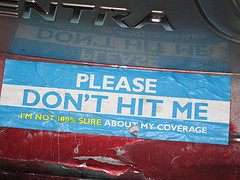Drive less, pay less.It seems to make perfect sense, doesn’t it? If you drive less, you pay less for gasoline and for maintenance items like tires, so why shouldn’t you pay for your auto insurance in the same way? There is a simple, beautiful logic to it.

flic.kr/p/5qo47u
Now TripSense, a usage-based auto insurance discount pilot program, is being offered to 5,000 drivers in Minnesota by the Progressive group of insurance companies, the third largest provider of auto insurance in the U.S. Program participants are eligible to receive a discount of up to 25 percent depending on how much, how fast and when they drive.
“How fast?” Hmmm. How does that work? Well, customers who register a vehicle in the TripSense pilot program plug a data-logging device into a port in their car, giving the
insurance company the right to collect driving data that includes speed.
While some might call the TripSensor, which collects the information about the vehicle’s use, just an invisible passenger, others question how the data might be used. In fact the specter of Big Brother watching our driving every second looms large. To some the potential cash advantages may be worth having one’s insurance company along as your co-pilot. Others might be a little more jealous of letting their insurer see–and potentially judge–how they drive. Participants in the TripSense program receive a five percent discount on the six-month premium for each registered vehicle. In subsequent policy periods, TripSense customers earn a five percent discount if they choose to upload their driving data to Progressive. Customers can also receive up to 20 percent more in discounts based on how much, how fast and when they drive. Sharing driving data with Progressive is always optional, but necessary to earn a discount in future policy terms.
Test pilot worked
Progressive tested this usage-based insurance discount program in Minnesota in early 2004 when it offered 250 drivers $25 to plug a data logging device into their vehicles to collect information for 30 days, upload their data to Progressive and complete a survey about the experience. In the test, a discount on future policy periods was not offered, but had it been, the average member of the test group would have been eligible for a 7.5 percent discount on the registered vehicle in the next policy period. Once installed, TripSensor records how much, how fast and when the vehicle is driven. This information is used to calculate the discount the customer may receive when they renew their policy. A note to those who like to accelerate briskly from a stop, TripSensor also collects information about rapid acceleration and braking that is not currently used to calculate the discount. The company says it is collecting this information to better understand if it is predictive of future accidents.
Cost reductions led to new version
Incidentally, this is the second time Progressive has gone down this road. The company was the first to test a usage-based insurance program that retrofitted Global Positioning System (GPS) and cellular technology into customers’ vehicles to calculate premium based in part on how much, when and where the vehicle was driven. This test, conducted in Texas, started in 1998 and concluded in 2001. While Progressive says the Texas test proved customers liked usage-based insurance because it saved them money and gave them more control over the cost of their auto insurance, it was discontinued due to high costs and complex installation logistics. Now, as the cost of electronic continues to fall, it will be interesting to see if usage-based insurance catches on. And it will also be interesting to see how much information drivers will be willing to share with their insurance companies. —Driving Today Managing Editor Jack R. Nerad writes frequently about car ownership issues, including auto insurance. © Studio One Networks.
Tagged with: insurance coverage • insurance premium
Filed under: Car Insurance